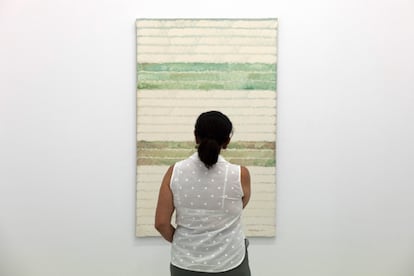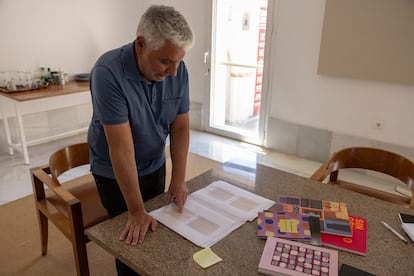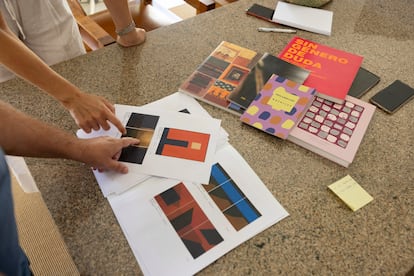Pepa Caballero, the great female figure of abstract art who was silenced for being a woman
The Andalusian Center of Contemporary Art (CAAC) is now recovering the work of the 1970s leader in Spanish art and preparing the first major retrospective exhibition of her paintings for next year

Her enormous paintings of refined beauty and her singular commitment to form, space and color show that Spanish artist Pepa Caballero (1943–2012) was an exceptional painter, with such unique works that there are hardly any role models or precedents in Spain. But she also stubbornly chose a difficult path that doomed her to invisibility: abstract painting, specifically, geometric abstraction. As writer Paul Valéry pointed out at the beginning of the last century, “the more abstract art is, the fewer the women there are among the people who made an illustrious name for themselves in it.” That is a dramatic claim with which the art historians, art critics and experts who came after the French intellectual agree. Historian Béatrice Joyeux-Prunel put it this way: “The history of the avant-garde is that of groups of men. It has been modeled entirely on male practices, which excluded women (and very often still exclude them now), if only because social and professional skills in the art world have long been reserved for them.”
Pepa Caballero knew it. There were women in realism and figuration, but abstract art was the preserve of men; women were prohibited. Even so, she was consistent with her chosen path. She had studied at the male-dominated University of Fine Arts in Seville, and she liked to “smoke and drink beer, talk about art and books with her male colleagues,” says University of Málaga professor Carmen Cortés. She was the only woman to be a member of the famous Colectivo El Palmo [El Palmo Collective], a group whose avant-garde language was far removed from conventional and commercial approaches, which she herself co-founded. Being a woman did not stop Caballero from pioneering the movement on a national scale or keep her work from standing out for her variations in composition and use of color and light, as well as for the meticulousness and handcrafted warmth with which she developed all her work. She was “an artist who imbued this geometric and stripped-down aesthetic with humanity, which made her memorable,” the expert says.

However, her name and her work faded with the passage of time. Today, 11 years after her death, she is an artist to be (re)discovered, and her life story is hidden by a veil of mystery. Why did she stop painting in the 1980s? Why did she not submit her work to contests, grants and awards from public institutions that would have promoted her work? Why did she elect to stay put in Málaga without exploring Madrid’s galleries?
“There’s a lot of uncertainty about that,” admits professor Carmen Cortés. She and her colleague Isabel Garnelo, both of the University of Málaga, are responsible for researching and locating Caballero’s work. Paradoxically, they note, “Pepa had a lot of recognition among her colleagues; it’s not that she was neglected in her time.” Similarly, “she was very aware of the importance of her work, she thought she was [very elegant and refined]. Pepa was a…vital, powerful, very strong lady. She was interested in life, [and] she was convinced of the value of her painting,” Garnelo adds.
Even so, “for whatever reason,” Caballero was not featured in the galleries that set the trends of the time. “Women did not generate confidence in the market.” It was as simple as that. Moreover, we don’t know the extent to which it as voluntary; there was a creative silence that coincided with the birth and upbringing of her children—she was a high school teacher in Torremolinos and also left that job—in the mid-1980s.
Before and after that pause, Caballero’s career was bookended by creative stages. The first phase was in the 1970s, when she burst onto the national artistic scene with large-format paintings dominated by red and black. Then, following her hiatus, she powerfully re-emerged in the 1990s after a change in her artistic sensibilities, informed by her knowledge of the classics, the specialists say.

Indeed, in 1992, Caballero made a trip to Greece that changed her aesthetic perception, imbuing it with a deep emotion that she combined with the desire for extreme rigor and perfection. Carmen Cortés explains that Caballero’s Parthenon and Mediterranean series, in which she introduced earthy and stone-like colors “and an even stricter geometry,” emerged from her experience. “But she died soon [thereafter], at a splendid moment in her artistic career, which would have definitively relaunched it,” adds Juan Antonio Alvarez Reyes, the director of the Andalusian Center of Contemporary Art.
Reyes is currently working with the two researchers to recover Caballero’s work. The Andalusian museum has acquired two sets of six pieces each (the series Black and Red and Mediterranean, which correspond to the two periods of her art career); they can be seen now in the group exhibition Devenir Pintura [The Evolution of Painting]. In addition, the institution is working on the donation of a similar lot and preparing for what will be Pepa Caballero’s first major retrospective exhibition in 2024. “It is inexplicable that her work has not been recovered until now; everyone who sees her paintings is impressed, so we hope that all this work, which we call Operation Caballero, will mean greater visibility,” says the director of the Andalusian Center of Contemporary Art (CAAC).
After the painter’s death in 2012, the two researchers from Málaga began contacting the artist’s two children and were surprised by the quantity—and quality—of the works stored in her studio in Málaga’s El Palo neighborhood. “We entered the house…[and were] amazed by the amount of paintings we found… [her] studio [had] large tables, because Pepa worked horizontally. [We’ve done] four years of work, but there is still a lot more to do; we have a struggle [going on] between our curiosity, the desire to tell a story, and respect for her two children’s grief. They are very discreet about their mother’s work, and we understand that it is not easy to manage a legacy,” the scholars say.
In fact, the painter’s work is mostly held by her children and her niece—also named Pepa Caballero—and surrounded by a story of love and family conviction in the painter’s courageous and determined work. “Without her knowing it, Pepa’s brother bought her work every time she exhibited,” and today he is one of her biggest collectors, say Garnelo and Cortés, who will curate the exhibition being prepared by the CAAC.

Nevertheless, one can follow the trail of this single female abstract artist’s work in several public collections in Málaga (at the Marbella Town Hall, the Provincial Council, the University of Málaga, the Museum of Contemporary Spanish Engraving in Marbella, the Unicaja Foundation and the Economic Society of Friends of the Country, among others); the collection at the University College of Zamora, the Aguilera Cerni MACVAC Museum in Castellón and at a university in Chicago... “We are currently in the process of locating her work, which we think could offer many surprises,” says Garnelo.
Pepa Caballero may be just the tip of the iceberg for getting to know the women painters who pursued abstract art in Spain in the 1970s, when the country was still in black and white. Beyond Soledad Sevilla, we know very little. “Or they haven’t been included,” acknowledges Cortés. Her colleague adds: “There are certainly many more women, you just have to look for them.
Sign up for our weekly newsletter to get more English-language news coverage from EL PAÍS USA Edition
Tu suscripción se está usando en otro dispositivo
¿Quieres añadir otro usuario a tu suscripción?
Si continúas leyendo en este dispositivo, no se podrá leer en el otro.
FlechaTu suscripción se está usando en otro dispositivo y solo puedes acceder a EL PAÍS desde un dispositivo a la vez.
Si quieres compartir tu cuenta, cambia tu suscripción a la modalidad Premium, así podrás añadir otro usuario. Cada uno accederá con su propia cuenta de email, lo que os permitirá personalizar vuestra experiencia en EL PAÍS.
¿Tienes una suscripción de empresa? Accede aquí para contratar más cuentas.
En el caso de no saber quién está usando tu cuenta, te recomendamos cambiar tu contraseña aquí.
Si decides continuar compartiendo tu cuenta, este mensaje se mostrará en tu dispositivo y en el de la otra persona que está usando tu cuenta de forma indefinida, afectando a tu experiencia de lectura. Puedes consultar aquí los términos y condiciones de la suscripción digital.
More information
Últimas noticias
There is as much life left to discover on planet Earth as that which is already known
Dozens presumed dead, around 100 injured in fire at Swiss Alps bar during New Year’s celebration
Is porn for women different from conventional porn? We spoke to those who make it
Cartagena de Indias is sinking: What can the city do to mitigate it?
Most viewed
- Reinhard Genzel, Nobel laureate in physics: ‘One-minute videos will never give you the truth’
- David King, chemist: ‘There are scientists studying how to cool the planet; nobody should stop these experiments from happening’
- Oona Chaplin: ‘I told James Cameron that I was living in a treehouse and starting a permaculture project with a friend’
- Sinaloa Cartel war is taking its toll on Los Chapitos
- The Interoceanic Train, the Mexican alternative to the Panama Canal











































